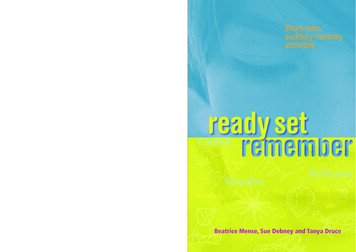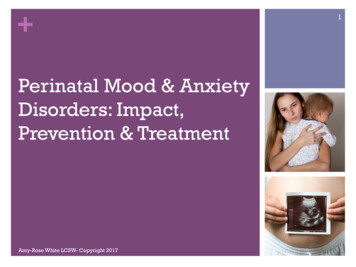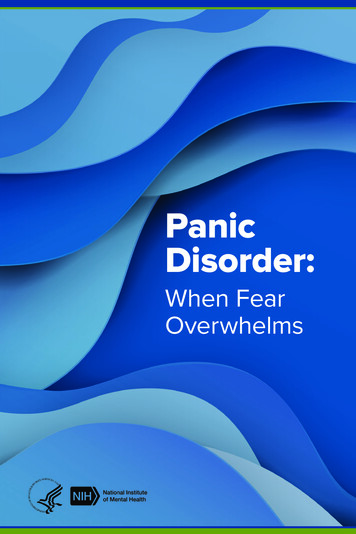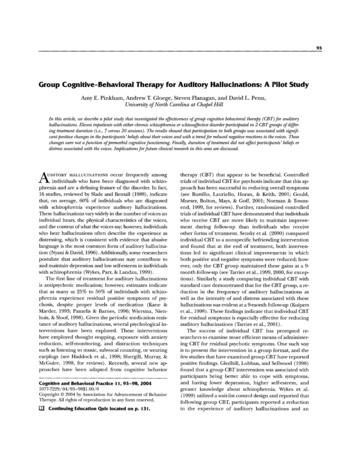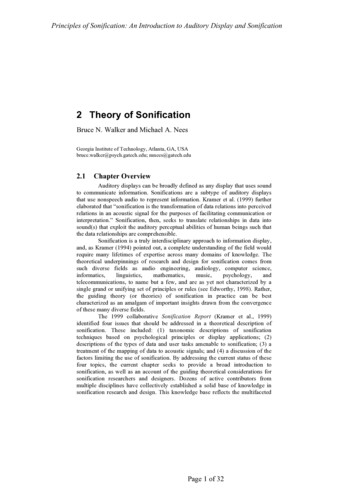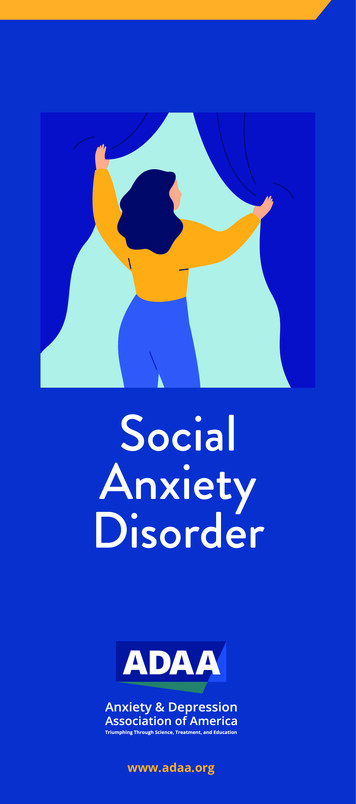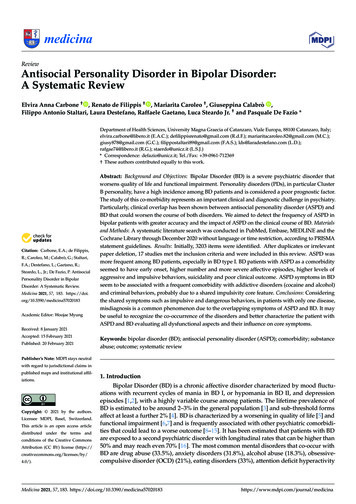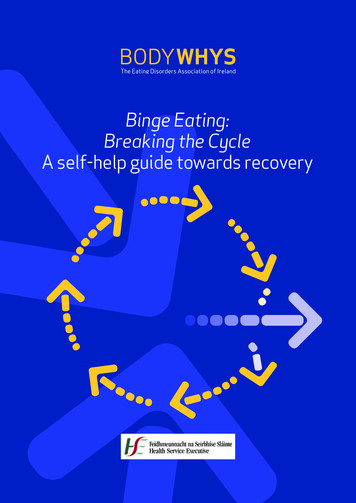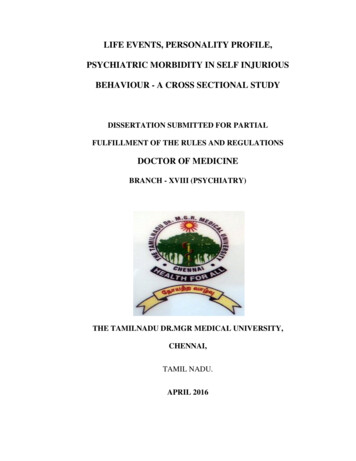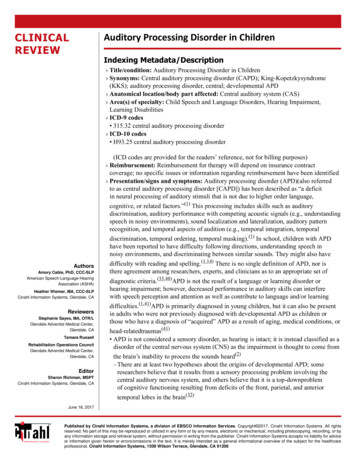
Transcription
CLINICALREVIEWAuditory Processing Disorder in ChildrenIndexing Metadata/Description› Title/condition: Auditory Processing Disorder in Children› Synonyms: Central auditory processing disorder (CAPD); King-Kopetzkysyndrome(KKS); auditory processing disorder, central; developmental APD› Anatomical location/body part affected: Central auditory system (CAS)› Area(s) of specialty: Child Speech and Language Disorders, Hearing Impairment,Learning Disabilities› ICD-9 codes 315.32 central auditory processing disorder› ICD-10 codes H93.25 central auditory processing disorder(ICD codes are provided for the readers’ reference, not for billing purposes)› Reimbursement: Reimbursement for therapy will depend on insurance contractcoverage; no specific issues or information regarding reimbursement have been identified› Presentation/signs and symptoms: Auditory processing disorder (APD)(also referredto as central auditory processing disorder [CAPD]) has been described as “a deficitin neural processing of auditory stimuli that is not due to higher order language,cognitive, or related factors.”(1) This processing includes skills such as auditorydiscrimination, auditory performance with competing acoustic signals (e.g., understandingspeech in noisy environments), sound localization and lateralization, auditory patternrecognition, and temporal aspects of audition (e.g., temporal integration, temporaldiscrimination, temporal ordering, temporal masking).(1) In school, children with APDhave been reported to have difficulty following directions, understanding speech innoisy environments, and discriminating between similar sounds. They might also haveAuthorsAmory Cable, PhD, CCC-SLPAmerican Speech-Language-HearingAssociation (ASHA)Heather Wiemer, MA, CCC-SLPCinahl Information Systems, Glendale, CAReviewersStephanie Sayes, MA, OTR/LGlendale Adventist Medical Center,Glendale, CATamara RussellRehabilitation Operations CouncilGlendale Adventist Medical Center,Glendale, CAEditorSharon Richman, MSPTCinahl Information Systems, Glendale, CAdifficulty with reading and spelling.(1,14) There is no single definition of APD, nor isthere agreement among researchers, experts, and clinicians as to an appropriate set ofdiagnostic criteria.(33,48)APD is not the result of a language or learning disorder orhearing impairment; however, decreased performance in auditory skills can interferewith speech perception and attention as well as contribute to language and/or learningdifficulties.(1,41)APD is primarily diagnosed in young children, but it can also be presentin adults who were not previously diagnosed with developmental APD as children orthose who have a diagnosis of “acquired” APD as a result of aging, medical conditions, orhead-relatedtraumas(41) APD is not considered a sensory disorder, as hearing is intact; it is instead classified as adisorder of the central nervous system (CNS) as the impairment is thought to come fromthe brain’s inability to process the sounds heard(2)–There are at least two hypotheses about the origins of developmental APD; someresearchers believe that it results from a sensory processing problem involving thecentral auditory nervous system, and others believe that it is a top-downproblemof cognitive functioning resulting from deficits of the front, parietal, and anteriortemporal lobes in the brain(32)June 16, 2017Published by Cinahl Information Systems, a division of EBSCO Information Services. Copyright 2017, Cinahl Information Systems. All rightsreserved. No part of this may be reproduced or utilized in any form or by any means, electronic or mechanical, including photocopying, recording, or byany information storage and retrieval system, without permission in writing from the publisher. Cinahl Information Systems accepts no liability for adviceor information given herein or errors/omissions in the text. It is merely intended as a general informational overview of the subject for the healthcareprofessional. Cinahl Information Systems, 1509 Wilson Terrace, Glendale, CA 91206
› Associated conditions: APD in children is associated with difficulties with language and higher order cognitive functions(1) Attention deficit disorder (ADD) or attention deficit hyperactivity disorder (ADHD)(3,36)–In a study conducted in the United States, researchers compared test performance among children with APD, childrenwith ADHD, and typically developing children on three different tests of central auditory function and their visualanalogs.(16) Participants included three groups of right-handed children: children without language, auditory, or learningdisorders(n 10; mean age, 12.6 years), children with ADHD (n 10; mean age, 13.2 years), and children with CAPD(n 7; mean age, 10.9 years) with typical hearing sensitivity and visual acuity. The authors found that deficits in childrenwith CAPD were not isolated to the auditory domain. The children with CAPD as well as the children with ADHDperformed worse on all tests in both visual and auditory domains compared with typically developing children.(16)Intratest comparisons showed that children with CAPD showed different patterns of performance on auditory teststhan children with ADHD. Researchers concluded that deficits in children with CAPD are not specific to the auditorymodality, a finding consistent with the “nonmodular” view of CAPD. They also concluded differentiation of children withCAPD from children with ADHD can be accomplished by using auditory tests alone as long as intratest comparisons areapplied–Researchers in Australia investigated the link between auditory processing and attention by examining the performanceon an auditory and visual sustained attention task of 101 children aged 7 to 12 years with listening difficulties(experimental group) and 18 children without listening difficulties (control group).(36) They found a low but significantcorrelation between auditory processing scores and sustained attention scores, suggesting that performance on these testsis affected by the same underlying trait. Nearly 50% of the children in the experimental group had either APD or attentiondeficit disorder, but not both. The researchers concluded that poor performance on auditory processing tests is not just aconsequence of attention deficit disorder, and that the two conditions are separate and largely independent Developmental dyslexia(3,4,5,47) Specific language impairment (SLI)(3,6,53) Learning disability(1)Causes, Pathogenesis, & Risk Factors› Causes: The cause of APD is usually unknown and is referred to as “developmental APD”. In a few cases, APD is due toCAS injury caused by traumatic brain injury (TBI), tumors, degenerative disorders, infections, surgical complications, orhypoxia and is referred to as “acquired APD.”(7) Many children with APD present with difficulties in learning, attention,articulation, spoken language, and written language. It is important to note that APD is correlated with but is not a result ofdysfunction in these modalities(1) Some studies have found a genetic component to APD; however, a specific gene responsible for APD has not beenidentified(1)› Pathogenesis: Although it is likely that APD arises from a neurological difficulty with processing auditory information, it isnot currently possible to identify the exact part(s) of the brain responsible for the development of APD(8) Authors of a case study in the United States identified CAPD in an 8-year-old male who had an arachnoid cyst in the lefttemporal lobe(8)› Risk factors There is evidence that long-term otitis media with effusion (OME) can result in reduced auditory processing ability inchildren due to auditory sensory deprivation(9,41,50) Males are twice as likely to be diagnosed with APD than females(10)Overall Contraindications/Precautions› The diagnosis of APD requires specific knowledge of topics that are generally not within the scope of the typical trainingof a speech-language pathologist (SLP) (e.g., cognitive neuroscience, neuropsychology, auditory neuroscience). Only anaudiologist with the appropriate training and skills (not an SLP) can make the diagnosis of APD(1,41)› The SLP’s role is to collaborate in the assessment and provide assistance in the differential diagnosis of APD fromother disorders with similar symptoms (e.g., language disorder due to hearing loss). A multidisciplinary assessment isrecommended to guide treatment of the disorder and related deficit(3)› A child’s parent(s) and/or caregiver(s) should be involved in all aspects of evaluation, including case history
Examination› History History of present illness/injury: Document history of APD; additional pertinent historical information can be obtainedfrom evaluation reports by the primary care physician, teacher(s), psychologist, otolaryngologist, neurologist, audiologist,or previous SLP–Mechanism of injury or etiology of illness: When was the patient diagnosed with APD and by whom?- Questions regarding medical history are intended to identify any medical factors that might have affected speech andlanguage development: complications during pregnancy or delivery, head injury, extended hospitalizations, otherdiagnoses, current health status, and medications. A medical history should also include questions about hearing and earinfections and whether the patient is currently receiving any type of intervention services(1)- History of mother’s pregnancy and delivery: Did the child’s mother have any illnesses, accidents, or complicationswhile pregnant with the child? Did the mother take any medications during the pregnancy? What was the length of thepregnancy? What was the duration of the delivery? What was the child’s weight at birth? Were there any complicationsor unusual circumstances during birth or shortly after? What were the Apgar scores?–Communication history: The answers given by parents/caregivers to questions about communication should determineany evidence of delay of communication milestones (e.g., babbling, first words, two-word combinations), listeningbehaviors, or history of hearing difficulties (including ear infections). Questions should also establish the caregivers’ levelof concern. In addition, a communication history should identify other language(s) spoken at home, daycare or school bythe child and caregivers(1)- Was the child a quiet or vocal infant? Did the child coo, babble, or imitate sounds as an infant? At what age did thesebehaviors begin? When did the child say his or her first word? At what age did the child begin to name objects orpeople? At what age did the child start to put words together (e.g., “Daddy up”)? Were the child’s first words easy ordifficult to understand?–Course of treatment- Medications for current illness/injury: Determine what, if any, medications the physician has prescribed; are theybeing taken?- Diagnostic tests completed: Review school and medical records, noting any pertinent diagnostic testing information- Home remedies/alternative therapies: Document any use of home remedies or alternative therapies (e.g., acupuncture)and whether or not they help- Musical auditory training has been used in patients with APD to improve auditory discrimination(11)- Previous therapy: Document whether patient has had speech, occupational, or physical therapy for this or otherconditions and what specific treatments were helpful or not helpful. If a child, has the patient received special educationservices?–Aggravating/easing factors: Are there certain times of day that the patient has more difficulty understanding? Are therespecific situations in which the patient reports more or less difficulty?–Nature of symptoms: Describe the nature of the symptoms; in which situations does the patient have difficulty?Specifically inquire about functional deficits in terms of listening ability in a variety of contexts.(48) Ask the parent/caregiver or child about the following symptoms:- Difficulty understanding speech in noisy environments or in the presence of competing messages(1,41)- Difficulty with sound localization and lateralization(1,41)- Frequent misunderstanding or inconsistent understanding of messages(1,41)- Frequent requests for repetitions(1,41)- Difficulty following complex auditory directions or commands(1,41)- Difficulty maintaining attention(1,36,41)- Being easily distracted(1,36,41)- Difficulty learning songs or nursery rhymes(1)- Poor musical or singing skills and/or appreciation of music(1,41)- Difficulty learning a foreign language or technical language(41)- Difficulty following rapid speech(41)
- Difficulty hearing on the phone(41)- Difficulty understanding subtle changes in prosody that indicate humor or sarcasm(41)- Children with APD might also have visual processing deficits; inquire about vision and refer to reports fromophthalmologist or other vision specialist if available(4)- Difficulty with reading and spelling(1,41)–Sleep disturbance: Document any difficulty sleeping–Psychosocial status: Briefly assess psychosocial status; if there are concerns regarding psychosocial status, includingsocial anxiety or frustration, refer to psychiatric professional for additional assessment and treatment as needed- In a study conducted in the United States, researchers compared 19 children (ages 9.5–17.8; mean 11.9) with APDto 20 gender- and age-matched children with no evidence of APD and found that the children with APD exhibitedincreased psychosocial difficulties compared to those without(12)- Children with APD were more likely to display negative emotional symptoms than those without APD(12)- Parents of the children with APD reported significantly more social and emotional difficulties for their children versusthe parents of the children without APD(12)–Hearing: Does the patient have a peripheral hearing loss? A referral to audiology should be made for a full audiologicalevaluation for patients with suspected APD who have not yet undergone audiological testing–Barriers to learning- Are there any barriers to learning? Yes No- If Yes, describe Medical history–Previous history of same/similar diagnosis: Has the patient been diagnosed with a speech or language disorder? Doesthe patient have a history of any motor or learning disorders? Has the patient been previously diagnosed with APD? If so,by whom? If APD has been previously diagnosed by anyone other than an audiologist, it might not be a valid diagnosis–Comorbid diagnoses: Inquire about comorbid diagnoses, including ADHD, autism spectrum disorder (ASD), hearingloss, learning disabilities, diabetes, cancer, head injury, psychiatric disorders, and orthopedic disorders–Medications previously prescribed: Obtain a comprehensive list of medications prescribed and/or being taken(including over-the-counter drugs)–Other symptoms: Ask the patient and caregiver about other symptoms the patient is experiencing Social/occupational history–Patient’s goals: Document what the patient and family/caregiver hope to accomplish with therapy and in general–Academic/school history: Did the child attend daycare or nursery school? Has the child received early interventionservices, including speech, physical, or occupational therapy? Have teachers ever reported any problems with the child’sspeech or language or made recommendations about speech therapy? In what grade is the child? What kind of grades ortest scores does the child usually achieve? In which subjects does the child perform best? In which subjects does the childperform worst? How does the child feel about school? Does the child receive special classes or instruction at school?Does the child make friends easily? Does the child interact with other children? Adults?–Vocation/avocation and associated repetitive behaviors, if any: What interests, hobbies, or other activities does thepatient have?–Functional limitations/assistance with ADLs/adaptive equipment: Does the patient have hearing loss that requireshearing aids or cochlear implants? Does the patient require/wear glasses? Does the child require any classroommodifications? Does the patient use a frequency modulation (FM) system? Is the classroom equipped with a whole-classsound system?–Living environment: To determine the quality and quantity of a child’s opportunities to communicate, obtain informationregarding his or her living environment (e.g., number of siblings and level of caregiver involvement) and educationalenvironment(1)- With whom does the patient live (e.g., caregivers)?- Describe the noise level of the child’s home environment on a scale of 1 to 10 (1 quiet all of the time, 10 loud withconstant environmental sounds such as the television, video games, or other children)- Is the patient exposed to any other languages at home or at school? If so, what percentage of time is the patient’sprimary language spoken around/to the patient? What percentage of time is another language spoken around/to thepatient?
› Relevant tests and measures: (While tests and measures are listed in alphabetical order, sequencing should beappropriate to patient medical condition, functional status, and setting.) Only an audiologist with the appropriatetraining and skills can make the diagnosis of APD.(1)Assessment procedures include a battery of behavioral tests andelectrophysiologicprocedures as well as observations and detailed case history.(41) For children suspected of having APD, acomprehensive assessment of speech, language, and literacy abilities is recommended(3,4,13,14) Screening–Screening checklists/questionnaires: Screening measures provide preliminary assessment of auditory behaviors relatedto academic achievement, listening skills, and communication. At present, there are no universally accepted methodsof screening for APD, and it is important that screening measures not be used for diagnostic purposes.(1) The AmericanAcademy of Audiology reported that screening measures for APD often result in over-referral of individuals and have notbeen validated(41)- Screening measures: Screening for APD often involves observation of listening behavior and/or performance on testsof auditory function and can be completed by any of the professionals involved in the patient’s multidisciplinary team.(1)Examples of screening measures include:- Differential Screening Test for Processing (DSTP):(38) Used to screen children aged 6 to 12 years to determine if thechild has difficulty with auditory or language processing and if further assessment is needed- SCAN-C: Test for Auditory Processing Disorders in Children-Revised:(40) Used as a screening or diagnostic test.Includes four tests of auditory processing for children aged 5 to 11 years- Questionnaires: In 2013, a Special Interest Group of the British Society of Audiology advocated for a validatedquestionnaire to screen for APD to replace or supplement clinical histories and to use as a functional benchmarkagainst behavioral and electrophysiological tests of auditory processing; as of this time, no validated questionnaires forscreening for APD exist.(39) Deficits investigated with questionnaires include: difficulty understanding spoken languagein noisy backgrounds, inconsistent responding, difficulty following complex instructions, difficulty localizing sound,and related reading, spelling, and learning problems Arousal, attention, cognition (including memory, problem solving): Refer to reports from school or clinicalpsychologist, neuropsychologist, teacher, physician, or learning disability specialist for detailed information regardingcognitive strengths and weaknesses as well as information on the child’s ability to engage in social interactions. Althoughpart of the diagnostic criteria for APD states that auditory processing difficulties cannot be explained by a “higher order”cognitive deficit, there is evidence that cognitive abilities influence performance on both auditory processing tasks as wellas on real-world, functional tasks.(49)Significant deficits in attention and working memory are frequently reported amongchildren with APD or suspected APD(49)–Researchers in the United Kingdom performed a factor analysis from the results of multimodal tests administered to 110children (6 and 11 years of age) with listening difficulties despite normal pure-tone audiograms (“suspected APD”) toidentify factors that might underlie listening difficulties.(37) Researchers identified two cognitive factors: 1) “workingmemory and executive attention” and 2) “processing speed and alerting attention” (maintaining a state of alertness).Nonverbal intelligence was not found to be an underlying dimension of APD. They concluded that children with APDneed to have a multimodal assessment to rule out comorbid conditions (e.g., language delay) and to ensure adequatetreatment for associated conditions Speech and language examination (including reading): A full assessment of communication skills with formal andinformal measures is appropriate for patients with APD or suspected APD. For detailed information on assessmentprocedures for speech, language, voice, fluency, and reading disorders, see the series of Clinical Reviews on these topics–Speech: Perform tests of articulation skills as well as phonological awareness.(15) For detailed information on assessmentof speech sound disorders, see the series of Clinical Reviews on these topics–Language: Assess receptive and expressive language skills. For detailed information on assessment of languagedisorders, see the series of Clinical Reviews on these topics–Voice: Document the presence of dysphonia, quality of breath support, and maximum phonation time. For detailedinformation on voice disorders in children, see Clinical Review Voice Disorders in Children: an Overview; Topic IDNumber: T709181–Fluency: Note moments of dysfluency/stuttering behaviors. For detailed information on assessment of fluency disorders,see the series of Clinical Reviews on stuttering and cluttering
–Reading/writing:Assess reading and writing skills as part of a complete evaluation of communication abilities whendevelopmentally appropriate; portions of standardized tests for language provide standardized tests of both reading andwriting. Also administer age-appropriate standardized tests of phonemic awareness, which is an important pre-readingand reading skill Sensory testing: Document the results of any audiological and visual testing that has been completed and ensure that thepatient has had an audiological evaluation prior to a communication evaluation Special tests specific to diagnosis: An audiologist performs an assessment for and makes the diagnosis of APD. Ingeneral, tests for central auditory processing abilities are those that “overload” the auditory system.(45) Although mostaudiologists believe it is necessary to use multiple tests to differentially diagnose APD, there is no “gold standard” testbattery or minimal set of tests that is universally agreed upon by audiologists.(30,45) Because there is no standardizedcriteria or test battery, the audiologist should qualify the diagnosis of APD with an explicit statement of the criteria usedfor diagnosis so that all professionals working with the patient have a shared understanding of his or her deficits, needs,and goals.(31) The test battery should include measures that examine a variety of central auditory nervous system processesin a sound-treated room.(30) Measures include both nonverbal (e.g., tones, clicks) and verbal stimuli in the individual’snative language to examine differences in auditory processing.(1) In addition, assessment of children in an educationalsetting should include organized classroom observations and diagnostic testing for language and academic achievement.The presence of a comorbid speech or language disorder can negatively affect the results of auditory processing tests.(30)Below are some of the possible tests that will completed by the audiologist during a diagnostic workup for APD–Peripheral hearing tests: A complete peripheral hearing evaluation including evaluation of hearing thresholds with puretone and bone conduction audiometry, immittance measures, and otoacoustic emissions should be performed to rule out orestablish the coexistence of peripheral hearing loss(1,45)–Auditory discrimination tests: To assess an individual’s ability to differentiate acoustic stimuli that differ in frequency,intensity, and/or temporal parameters(1)–Auditory temporal processing and patterning tests: To assess an individual’s ability to analyze acoustic events overtime (e.g., sequencing patterns, forward and backward masking)(1)–Dichotic speech tests: To assess the ability to separate or integrate different auditory stimuli presented to both earssimultaneously(1,45)- Dichotic Digits difference Test (DDdT): A test commonly used in research studies on APD in which different numbersare presented simultaneously to both ears and the individual is asked to say back all of the numbers heard.(51,52)Testdevelopers caution interpretation of results in children with known cognitive impairment, especially with respect tomemory and attention. This test would likely not be appropriate for a child with a comorbid diagnosis of ADHD forexample(52)–Monaural low-redundancy speech tests (also called low-pass filtered speech tests [LPFSTs]): To assess the abilityto recognize poor quality speech stimuli presented to one ear at a time; the listener hears speech stimuli that has beendegraded in some way (e.g., increased speed) and has information missing and is asked to repeat what they hear(1)–Binaural interaction tests: To assess binaural processes that are dependent on intensity or time differences of acousticstimuli (e.g., localization, lateralization); binaural tests assess the ability for both ears to work together(1,45)–Electroacoustic measures: To assess acoustic signals in the ear canal that are generated spontaneously or in response toacoustic stimuli (e.g., OAEs)(1)–Electrophysiologic measures: Recordings of electrical potentials that are reflective of CNS activity in response toacoustic events (e.g., cortical auditory evoked potentials)(1)- Authors of a systematic review discussed 4 studies that involved school-aged children with APD who were treatedwith auditory training and whose outcomes were compared to a treated and/or an untreated control group usingelectrophysiological measures. The authors found that the current evidence base was too small and too weak to provideclear guidance regarding the usefulness of electrophysiological measures as an outcome measure for auditory trainingwith children with APD(34)–Speech Perception In Noise (SPIN) test: Language-based test with 10 recorded lists of 50 sentences spoken against abackground of babbling noise; half of the sentences are “highly predictable” (e.g., Hot wax dripped from the candle.) andhalf are “low predictable” (e.g., Paul doesn’t need a candle.). Subject listens to the sentences with the speech babble noiseand repeats the final word in each sentence; the recognition score of key words for the highly predictable words represents
the ability to use semantic cues to understand the sentence and the score for the low predictable words represents thebottom-up auditory processing of the acoustic signal(17,45)–In a retrospective study conducted in the United States with 56 children who were referred for CAPD assessment,researchers examined the failure rates of different combinations of tests commonly used in APD assessments. Of the 56children included in the study, 28 had been diagnosed with CAPD after these tests were administered and the other 28were considered to have “normal processing” because they passed all or all but one of these tests. The test failed mostfrequently by the children with CAPD was the frequency pattern test (in which the child is asked to listen to differentpatterns and determine what they have just heard [e.g., “high-low-high”]) with an 82% failure rate. The combinationof an LPFST with a frequency pattern test had the highest failure rate among the children with CAPD at 60%. Wheneither of these two tests was combined with a competing sentences test (i.e., dichotic speech tasks), the failure rate wasapproximately 50%. Researchers concluded that it is essential to assess a range of auditory abilities with a variety of testswhen differentially diagnosing CAPD because no single test or combination of tests will accurately diagnose all childrenwith CAPD(46)Assessment/Plan of Care› Diagnosis/need for treatment: The diagnosis of APD is made by an audiologist and requires a level of performance at leasttwo standard deviations below the mean in at least one ear on two or more tests in the battery(1,41)› Rule out: Fatigue or lack of motivation can contribute to inconsistent test results and it is important to distinguish APD fromthese contributing factors. Hearing loss should be ruled out prior to the administration of a APD examination.(10) In addition,APD must be distinguished from language impairment due to other factors (e.g., hearing loss), ASD, and ADHD(1,10)› Prognosis: Prognosis will vary depending on factors such as chronological and developmental age, cognitive abilities(e.g., attention and memory), language age and experience, cultural and social background, motivation, and medications.Treatment is highly individualized and deficit-specific. It is difficult to determine the degree to which improvement inauditory processing abilities will occur. Some children do not have auditory deficits in adulthood while others continue tohave residual deficits(42)› Referral to other disciplines: Refer to an audiologist. Referral to ophthalmologist, learning disability specialist, and/orsocial work/psychologist might be appropriate for patients with APD› Other considerations: In countries with linguistically and culturally diverse populations such as India and South Africa,audiologists are challenged in their ability to accurately assess for and diagnose APD due to the appropri
American Speech-Language-Hearing Association (ASHA) Heather Wiemer, MA, CCC-SLP Cinahl Information Systems, Glendale, CA . Cinahl Information Systems accepts no liability for advice . professional. Cinahl Information Systems, 1509 Wilson Terrace, Glendale, CA 91206 Auditor y Processing Disorder in Children Indexing Metadata/Description
